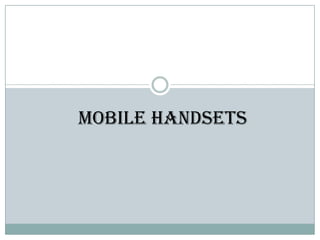Mobile handests ppt
- 2. Contents ï Introduction ï Handset Architecture ï Handset Operating Systems ï Generations of mobile technology ï Mobile handsets according to technology
- 3. What Is A Mobile Handset? ï A mobile handset (handset) is an electronic device that provides services to users, e.g.: ïĄ Managing address book ïĄ Scheduling calendar ïĄ Cellular telephony Example handsets: ïĄ Accessing Internet, email Apple iPhone, BlackBerry Storm, Palm TreoPro ï Handsets include smartphones and PDAs
- 4. Whatâs Inside a Mobile Handset? Source: [3]
- 5. Handset Architecture (1) ï Handsets use several hardware components: ïĄ Microprocessor ïĄ ROM ïĄ RAM ïĄ Digital signal processor ïĄ Radio module ïĄ Microphone and speaker ïĄ Hardware interfaces ïĄ LCD display
- 6. Handset Architecture (2) ï Handsets store system data in electronically-erasable programmable read-only memory (EEPROM) ïĄ Service providers can reprogram phones without requiring physical access to memory chips ï OS is stored in ROM (nonvolatile memory) ï Most handsets also include subscriber identity module (SIM) cards
- 7. SIM Cards ï They include their own microprocessor and 16 KB â 4 MB EEPROM ï They come in two sizes ï Their versatility arises from portability of information ïĄ SIM card identifies subscriber to network ïĄ Stores personal information, address books, messages, service- related information
- 8. Handset Operating Systems ï Currently, handsets run several OSes: ïĄ Symbian OS ïĄ iPhone OS (an embedded version of OS X) ïĄ Windows Mobile ïĄ BlackBerry OS ïĄ Google Android Platform (based on Linux) ï With the exceptions of Symbian and Android, these OSes are proprietary [9â10] ï Telecom carriers frequently âlock downâ handset firmware, OSes to prevent user modifications
- 9. Advantages of mobile technologies
- 11. 0G TELEPHONES
- 13. Ex for 2G MOBILE HANDSET
- 14. Ex for 3G mobile handset
- 15. Some examples for 4G mobile handsets
- 16. CONCLUSION ï So by this presentation we can examine that as the technology is developing the compatibility and the features of the mobile handsets are increasing day by day.




![Whatâs Inside a Mobile Handset?
Source: [3]](https://image.slidesharecdn.com/mobilehandestsppt-121220085624-phpapp02/85/Mobile-handests-ppt-4-320.jpg)



![Handset Operating Systems
ï Currently, handsets run several OSes:
ïĄ Symbian OS
ïĄ iPhone OS (an embedded version of OS X)
ïĄ Windows Mobile
ïĄ BlackBerry OS
ïĄ Google Android Platform (based on Linux)
ï With the exceptions of Symbian and Android,
these OSes are proprietary [9â10]
ï Telecom carriers frequently âlock downâ handset
firmware, OSes to prevent user modifications](https://image.slidesharecdn.com/mobilehandestsppt-121220085624-phpapp02/85/Mobile-handests-ppt-8-320.jpg)








